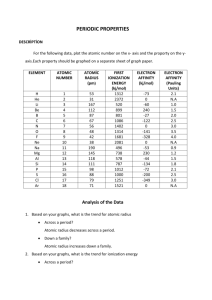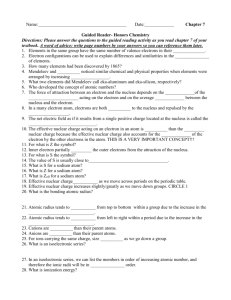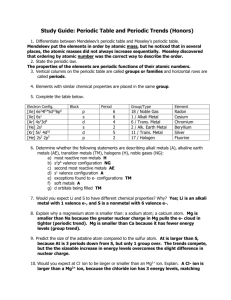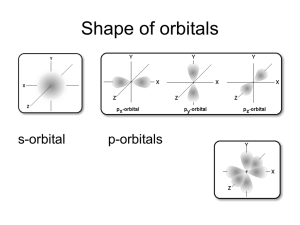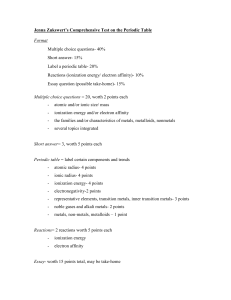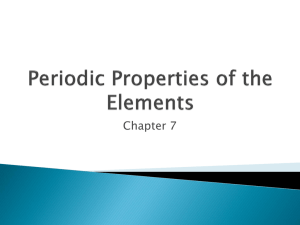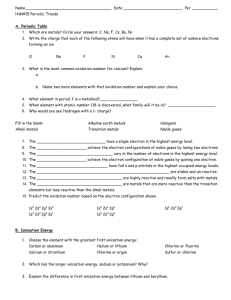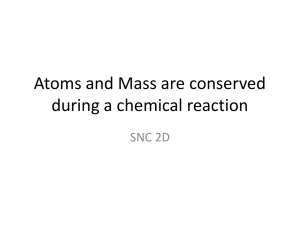Per. Props. Practice Test
advertisement
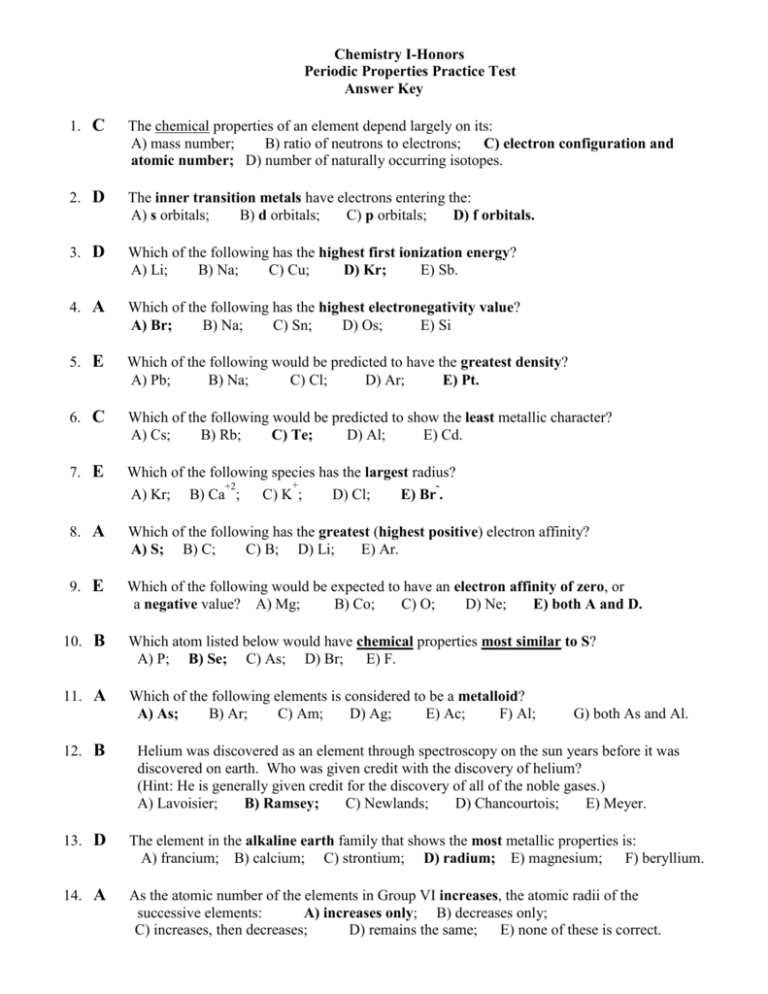
Chemistry I-Honors Periodic Properties Practice Test Answer Key 1. C The chemical properties of an element depend largely on its: A) mass number; B) ratio of neutrons to electrons; C) electron configuration and atomic number; D) number of naturally occurring isotopes. 2. D The inner transition metals have electrons entering the: A) s orbitals; B) d orbitals; C) p orbitals; D) f orbitals. 3. D Which of the following has the highest first ionization energy? A) Li; B) Na; C) Cu; D) Kr; E) Sb. 4. A Which of the following has the highest electronegativity value? A) Br; B) Na; C) Sn; D) Os; E) Si 5. E Which of the following would be predicted to have the greatest density? A) Pb; B) Na; C) Cl; D) Ar; E) Pt. 6. C Which of the following would be predicted to show the least metallic character? A) Cs; B) Rb; C) Te; D) Al; E) Cd. 7. E Which of the following species has the largest radius? + +2 A) Kr; B) Ca ; C) K ; D) Cl; E) Br . 8. A Which of the following has the greatest (highest positive) electron affinity? A) S; B) C; C) B; D) Li; E) Ar. 9. E Which of the following would be expected to have an electron affinity of zero, or a negative value? A) Mg; B) Co; C) O; D) Ne; E) both A and D. 10. B Which atom listed below would have chemical properties most similar to S? A) P; B) Se; C) As; D) Br; E) F. 11. A Which of the following elements is considered to be a metalloid? A) As; B) Ar; C) Am; D) Ag; E) Ac; F) Al; 12. B G) both As and Al. Helium was discovered as an element through spectroscopy on the sun years before it was discovered on earth. Who was given credit with the discovery of helium? (Hint: He is generally given credit for the discovery of all of the noble gases.) A) Lavoisier; B) Ramsey; C) Newlands; D) Chancourtois; E) Meyer. 13. D The element in the alkaline earth family that shows the most metallic properties is: A) francium; B) calcium; C) strontium; D) radium; E) magnesium; F) beryllium. 14. A As the atomic number of the elements in Group VI increases, the atomic radii of the successive elements: A) increases only; B) decreases only; C) increases, then decreases; D) remains the same; E) none of these is correct. 15. A Which of the following substances would have the highest melting point? A) W; B) Ca; C) Br; D) I; E) Cd. 16. A The energy associated (gained or lost) with the addition of an electron to a neutral atom is known as the element's: A) electron affinity; B) electronegativity; C) ionization energy; D) potential ionic charge; E) shielding effect. 17. B High electronegative values are characteristic of: A) metals; B) nonmetals; C) metalloids; 18. Rb 19. C 20. Cl 21. B D) noble gases. Which of the first 40 elements gives up an electron most readily? Which of the following elements shows the greatest affinity for an additional electron? A) Li; B) Fr; C) Se; D) As; E) Ne. Which is the most active nonmetal in Period 3? Which of the following is a rare earth metal? A) Np; B) Gd; C) Cd; D) Pd; E) both A and B. 22. Cs Which nonradioactive alkali metal tends to be a liquid at a slightly elevated room temperature? 23. D Which of the following species would have the smallest ionic radius? +2 -3 +2 +2 A) Nb ; B) Cl ; C) N ; D) Mg ; E) Zn . 24. B Which of the following elements is a halogen? A) Al; B) Br; C) Au; D) Ge; 25. E 26. E E) Te. Which of the following is a member of the transuranium elements? A) holmium; B) strontium; C) fermium; D) curium; Which of the following would be classified as a noble metal? A) Sr; B) Cu; C) Nd; D) Pb; E) Pt; E) both C and D. F) Ar. 27. C Which of the following elements would exhibit the best electrical conductivity? A) Fe; B) Ba; C) Au; D) Ga; E) I. 28. A In general, the electronegativity of elements is smallest for: A) alkali metals; B) nonmetals; C) noble gases; D) coinage metals; E) transition metals. 29. D Whose work with X rays helped modify the periodic table to its modern form so that elements are arranged according to atomic number and not atomic weight? A) Mendeleev; B) Meyer; C) Newland; D) Moseley; E) Dobereiner. 30. A Who is generally given credit for developing the periodic table? A) Mendeleev; B) Meyer; C) Newlands; D) Moseley; E)Dobereiner. 31. A Which of the following elements is a chalcogen? A) tellurium; B) lead; C) iodine; D) nickel; E) sodium. 32. B Which of the following is not a property of a nonmetal? A) poor electrical conductivity; B) high luster; C) poor thermal conductivity; D) high ionization energy; E) all of these are traits of nonmetals. 33. E Which of the following group of elements exhibit all three phases of matter at room temperature? A) II-A; B) IV-A; C) II-B; D) VI-B; E) VII-A. 34. A Which is an important characteristic of the transition elements? A) They generally have more than one valence. B) They are magnetic. C) They are all amphoteric elements. D) Their f subshells are partially filled. E) They have identical chemical properties. 35. C Which of the following elements is classified as a coinage metal? A) cobalt; B) nickel; C) copper; D) platinum; E) both B and C. 36. D Which of the following inert gases would have the highest boiling point? A) Ne; B) Ar; C) Kr; D) Xe 37. E Salts with which one of the following metallic salts will most probably have color? A) Na; B) Sr; C) Al; D) Li; E) Co. 38. B What element is the only nonmetal that is a liquid at room temperature? A) Hg; B) Br; C) Fr; D) Ga; E) I. 39. E Which of the following, when dissolved in water, should produce a pH less than 7? A) Na2O; B) BaO; C) H2O; D) CrO; E) CO2 40. E Salts of which of the following metals produces a lavender color in a flame test? A) Ca; B) Ba; C) Cu; D) Na; E) K; F) Cs; G) Sr 41. C Salts of which of the following metals produces a green color in a flame test? A) Ca; B) Ba; C) Cu; D) Na; E) K; F) Cs; G) Sr =========================================================================== Essays: 1. Explain why hafnium and zirconium are so similar in both chemical and physical properties. Why aren't zirconium and tantalum more similar in terms of physical properties since Ta is perpendicular to the diagonal? 2. Compare and contrast the alkali metals and the coinage metals. Give one example from each group. List two properties that they share in common and two properties in which they differ. 3. Consider the chalcogens. Discuss their periodic trends in terms of ionization energies, electron affinity, metallic properties, and acid-base properties. 4. The first ionization energies are given for four elements. Make four different comparisons between the elements and explain why their ionization energies differ. Si = 8.151 V; P = 10.486 V; S = 10.360 V; As = 9.81 V 5. Explain the “lanthanide contraction” and tell how it affects the physical property of density.

